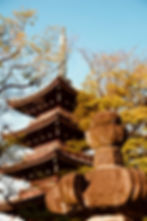Ueno Toshogu Shrine – Edo’s Golden Legacy in the Heart of Ueno Park | MK Deep Dive
- M.R. Lucas
- Aug 7
- 3 min read

Beyond the bronze statue of Prince Komatsu Akihito, the imperial army commander who fought for the Meiji government in the Boshin War, helping to end the shogunate and restore imperial rule, you’ll find Ueno Toshogu Shrine. It’s situated near the zoo, where Tokyo’s popular pandas attract visitors, and next to the five-story pagoda—a remnant of a past syncretic period when Kan’ei-ji Temple once occupied almost the entire park.
This is Toshogu, the shrine where Tokugawa Ieyasu, the founder of the Tokugawa Shogunate that ruled Japan for more than 250 years, is enshrined. He is the most notable shogun memorialized in the park, and his influence endures, even in a space transformed by modernization. Much of the original Edo-period scenery was lost to fire, war, and reforms during the Meiji era that replaced temples with zoos and museums.

Pass through a monolithic torii, walk along a cobbled path lined with stone lanterns donated by feudal lords (daimyō), and, if you wish, stop to wash your hands and rinse your mouth at the temizuya purification basin. The towering pagoda — symbolizing the influence of Chinese-imported Buddhism — peeks through the trees and over the fence of the nearby zoo, which was once part of the shrine grounds before being sold to the government for protection during the early 20th century’s Buddhist persecutions. All of this, justified under the guise of imperial nationalism and Shinto revivalism, the indigenous religion of the Yamato, whose founder cannot be traced back to.
The shrine, an excellent example of gongen-zukuri architecture, was reconstructed by the third shogun, Tokugawa Iemitsu, in 1651. Its original construction dates back to 1627. While Ieyasu’s remains are housed at Nikkō Toshogu, this shrine was built in Edo’s capital to allow locals to pay their respects without having to venture into the distant northern wilderness.
The outer grounds, open to the public at no charge, contain a collection of sacred relics: a towering “ghost lantern” believed to be one of Japan’s largest, a stage for kagura (sacred music and dance), and legendary komainu lion-dog guardians. Signs in the pebble garden politely inform visitors not to pick up, take, or throw stones — every rule is in place for a reason.

Dragons are believed to gather nearby in the waters, swirling up through the golden foil gate and weaving among its detailed carvings of birds and peonies. For ¥500, you can cross the barrier to access a peaceful inner area. Inside, a modern meditation space crafted from recycled ginkgo wood stands opposite a 600-year-old ginkgo tree—the oldest in Ueno—wrapped in sacred shimenawa rope, believed to be protected by divine spirits. When I tried to photograph its massive trunk with my film camera, the shutter froze. This could be due to my poor technique or something else. You decide.

Nestled in a shaded corner of the grounds is a small auxiliary shrine. University students come here to pray for good luck in exams and job interviews, making offerings to a raccoon dog (tanuki) statue. This statue once brought misfortune to the shogunate until it was consecrated at this site during the Taishō era, after which it began to exhibit a benevolent nature.
Most of Toshogu’s beauty can be appreciated from the public path, but approaching closer offers a different view. The shrine is decorated with hawks, phoenixes, and Chinese guardian lions — all rich in symbolism and well-preserved. Soft blue accents lighten the dominant gold. The twin doors appear as two fused golden bars, carved with the Tokugawa crest. These doors open into three sealed chambers: the worship hall, the offering hall, and the inner sanctum, which houses the spirit of Tokugawa Ieyasu—unfortunately, closed to the public.

This sanctuary has endured events that destroyed much of Tokyo, including the Great Kantō Earthquake, World War II bombings, and rapid redevelopment. It stands as one of the few remaining original Edo-period structures in the city. The tomb, dedicated to a military leader who unified Japan—and, some believe, ushered in a period of peace—remains of great sacred importance.
Visitors bow, clap, and pray for good fortune, health, success, and long life — or all of the above — as they clap into the silent void, hoping their prayers reach beyond the golden doors.
Let MK Guide You Into the Golden Silence
Behind the zoos, museums, and modern walkways of Ueno, a shimmering trace of a bygone era remains. Let MK walk with you into a world where dragons swirl through golden gates, ancient trees conceal silent secrets, and echoes of the Tokugawa shogunate still whisper between the lanterns.

Image Credits
Photographs by NatalieTracy are licensed under CC BY-SA 2.0.
Photographs by foooomio are licensed under CC BY 2.0.
